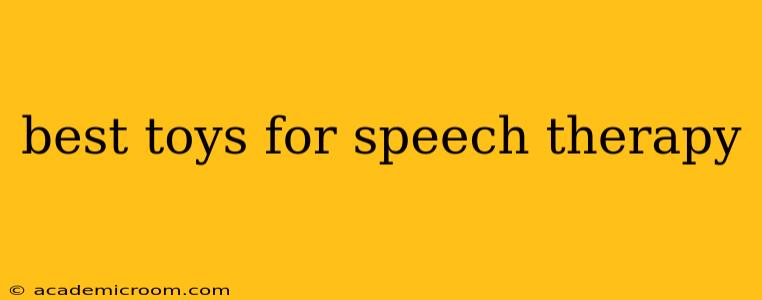Choosing the right toys can significantly impact a child's speech therapy journey. The best toys for speech therapy aren't just fun; they're carefully selected tools designed to target specific speech and language skills. This guide explores a range of toys categorized by the skills they develop, helping you find the perfect options for your child or client. We'll also address some frequently asked questions to provide a comprehensive understanding of toy selection for speech therapy.
What are the best toys for articulation therapy?
Articulation therapy focuses on the clear production of individual sounds. Toys that encourage precise mouth movements and sound repetition are ideal. Think about toys that require specific sounds to operate, or those that inherently involve repetitive actions and sounds.
- Bubbles: Blowing bubbles is a fantastic exercise for breath control and the precise articulation of the /p/, /b/, and /m/ sounds. The visual element adds engagement, making it fun for children.
- Kazoo: The kazoo encourages buzzing sounds, helping to develop the sounds /z/ and /v/. The simple mechanism makes it accessible for various age groups and skill levels.
- Musical Instruments: Instruments like shakers, tambourines, and xylophones can improve breath control and articulation. Encourage children to make specific sounds while playing, targeting specific phonemes.
- Parachute Toys: These toys require collaborative play and encourage children to make various sounds while engaging in interactive games.
What are the best toys for language development?
Language development encompasses a broad spectrum of skills, including vocabulary, grammar, and narrative skills. The best toys here will stimulate conversation, storytelling, and symbolic play.
- Building Blocks: Blocks facilitate spatial reasoning and descriptive language. Encourage children to describe their creations, using precise vocabulary. LEGOs are a fantastic example, offering endless possibilities for creative expression.
- Puzzles: Puzzles, especially those with thematic narratives, aid in vocabulary expansion and narrative development. Discuss the pictures and elements of the puzzle while assembling it.
- Play-Doh or Modeling Clay: These materials spark creativity and provide opportunities for describing shapes, colors, and textures. Encourage children to describe their creations and the steps involved in making them.
- Dress-Up Clothes and Puppets: These promote imaginative play and storytelling. Encourage children to create narratives with their characters, developing their fluency and expressive language.
What are some good toys for receptive language?
Receptive language focuses on understanding spoken language. Toys that involve following directions and comprehending instructions are particularly beneficial.
- Simple Board Games: Games with clear rules and instructions help children follow directions and understand concepts. Start with games that have fewer rules and gradually increase complexity.
- Picture Cards and Matching Games: These games focus on matching images to words or concepts, improving vocabulary comprehension and understanding.
- Action Games: Games involving simple commands like “jump,” “clap,” or “touch your nose” are crucial in developing receptive language skills. Ensure the instructions are clear and easy to understand.
What types of toys are best for practicing pragmatics in speech therapy?
Pragmatics refers to the social use of language. Toys that encourage turn-taking, communication, and social interaction are vital for developing pragmatic skills.
- Toy Phones and Walkie-Talkies: These toys encourage pretend conversations, role-playing, and the development of communication strategies.
- Cooperative Board Games: These require turn-taking, negotiation, and communication, fostering social interaction and pragmatic skills.
- Storytelling with Props: Utilizing dolls, animals, or other props during storytelling sessions encourages imaginative play and narrative creation, enhancing the social aspect of language.
What are some affordable speech therapy toys?
Many effective speech therapy toys are readily available at affordable prices. Simple household items can even be adapted for this purpose.
- Household Items: Spoons, cups, and containers can be used for sound practice.
- Recycled Materials: Cardboard boxes can become houses or castles for imaginative play.
- Crayons and Paper: These allow for drawing and descriptive language activities.
- Picture Books: Affordable books are essential for narrative development and vocabulary building.
Remember, the best toy for speech therapy is one that is engaging, age-appropriate, and targets specific speech and language skills. Consult with your child's speech-language pathologist to identify the most appropriate toys for their individual needs and goals. Regular play and interaction with these toys, coupled with targeted therapy, can greatly enhance language development and communication skills.
